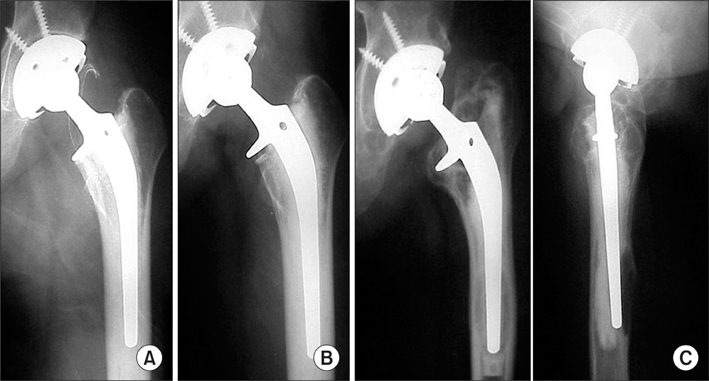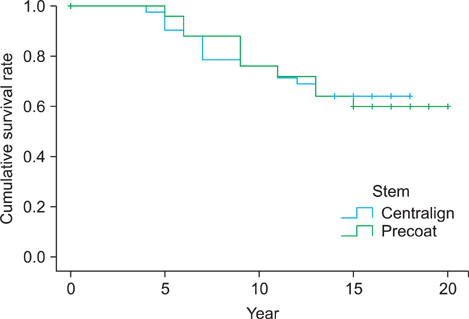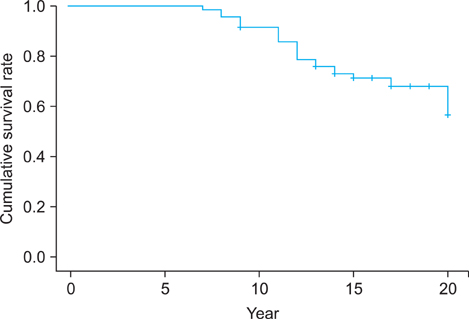Clin Orthop Surg.
2013 Jun;5(2):110-117. 10.4055/cios.2013.5.2.110.
Fifteen-year Results of Precoated Femoral Stem in Primary Hybrid Total Hip Arthroplasty
- Affiliations
-
- 1Department of Orthopaedic Surgery, Korea University Ansan Hospital, Ansan, Korea.
- 2Department of Orthopaedic Surgery, Seoul Veterans Hospital, Seoul, Korea.
- 3Department of Orthopaedic Surgery, Korea University Guro Hospital, Seoul, Korea. mayhap00@naver.com
- KMID: 1705531
- DOI: http://doi.org/10.4055/cios.2013.5.2.110
Abstract
- BACKGROUND
There has been controversy whether methylmethacrylate precoating of the cemented femoral stem is a solution for aseptic loosening or rather contributes to increased failure rates in cemented total hip arthroplasties.
METHODS
On a retrospective basis, we analyzed 76 primary hybrid total hip arthroplasties from 63 patients with precoated, cemented femoral stems between October 1990 and December 1995. The mean age of the patients was 46.8 years (range, 22 to 77 years) with a minimum follow-up of 14 years (mean, 15.5 years; range, 14 to 19.5 years). Third generation cementing techniques were employed in all cases.
RESULTS
Twenty-four out of 76 cases (31.6%) showed aseptic loosening of the femoral stems, of which 23 stems were revised at an average revision time of 8 years (range, 3 to 14.8 years). The main mode of loosening was cement-stem interface failure in 22 hips (91.7%). Twenty-one out of 24 failed hips (87.5%) demonstrated C2 cementing grades (p < 0.001). Kaplan-Meier survivorship analysis using radiographic aseptic loosening of the femoral stem as the endpoint for failure showed survival rates of 76.5% at 10 years (95% confidence interval [CI], 71.4 to 81.6) and 63.2% at 19 years (95% CI, 57.3 to 69.1).
CONCLUSIONS
An early failure of the precoated femoral stem in this study was mainly due to an insufficient cementing technique. Achievement of good cement mantle may improve the survival rates.
MeSH Terms
-
Adult
Aged
Aged, 80 and over
Arthroplasty, Replacement, Hip/*instrumentation
*Coated Materials, Biocompatible
Equipment Failure Analysis
Female
Femur Head Necrosis/diagnosis/surgery
*Hip Prosthesis
Humans
Kaplan-Meier Estimate
Male
Methylmethacrylate
Middle Aged
Prosthesis Failure
Retrospective Studies
Treatment Outcome
Young Adult
Coated Materials, Biocompatible
Methylmethacrylate
Figure
Cited by 3 articles
-
Revision Hip Arthroplasty with a Cementless Femoral Stem
Young-Yool Chung, Chae-Hyun Lim, Chung-Young Kim, Jeong-Seok Kim
Hip Pelvis. 2013;25(4):260-266. doi: 10.5371/hp.2013.25.4.260.Long-term Outcome of Polished Stems in Total Hip Arthroplasty
Jin-Young Park, Hong-Joon Han, Seok-Jong Baik, Suc-Hyun Kweon
Hip Pelvis. 2015;27(2):83-89. doi: 10.5371/hp.2015.27.2.83.Total Hip Arthroplasty: Past, Present, and Future. What Has Been Achieved?
Won Yong Shon, Beyoung-Yun Park, Rajsankar N R, Phil Sun Park, Jung Taek Im, Ho Hyun Yun
Hip Pelvis. 2019;31(4):179-189. doi: 10.5371/hp.2019.31.4.179.
Reference
-
1. Ito H, Matsuno T, Minami A. Pre-coated femoral components in hybrid total hip arthroplasty: results at 11 years. J Bone Joint Surg Br. 2005. 87(3):306–309.2. Sylvain GM, Kassab S, Coutts R, Santore R. Early failure of a roughened surface, precoated femoral component in total hip arthroplasty. J Arthroplasty. 2001. 16(2):141–148.
Article3. Clohisy JC, Harris WH. Primary hybrid total hip replacement, performed with insertion of the acetabular component without cement and a precoat femoral component with cement: an average ten-year follow-up study. J Bone Joint Surg Am. 1999. 81(2):247–255.
Article4. Dowd JE, Cha CW, Trakru S, Kim SY, Yang IH, Rubash HE. Failure of total hip arthroplasty with a precoated prosthesis: 4- to 11-year results. Clin Orthop Relat Res. 1998. (355):123–136.5. Barrack RL, Mulroy RD Jr, Harris WH. Improved cementing techniques and femoral component loosening in young patients with hip arthroplasty: a 12-year radiographic review. J Bone Joint Surg Br. 1992. 74(3):385–389.
Article6. Mulroy WF, Estok DM, Harris WH. Total hip arthroplasty with use of so-called second-generation cementing techniques: a fifteen-year-average follow-up study. J Bone Joint Surg Am. 1995. 77(12):1845–1852.
Article7. Gruen TA, McNeice GM, Amstutz HC. "Modes of failure" of cemented stem-type femoral components: a radiographic analysis of loosening. Clin Orthop Relat Res. 1979. (141):17–27.8. Harris WH, McCarthy JC Jr, O'Neill DA. Femoral component loosening using contemporary techniques of femoral cement fixation. J Bone Joint Surg Am. 1982. 64(7):1063–1067.
Article9. Oishi CS, Walker RH, Colwell CW Jr. The femoral component in total hip arthroplasty: six to eight-year follow-up of one hundred consecutive patients after use of a third-generation cementing technique. J Bone Joint Surg Am. 1994. 76(8):1130–1136.
Article10. Mohler CG, Callaghan JJ, Collis DK, Johnston RC. Early loosening of the femoral component at the cement-prosthesis interface after total hip replacement. J Bone Joint Surg Am. 1995. 77(9):1315–1322.
Article11. Goldberg VM, Ninomiya J, Kelly G, Kraay M. Hybrid total hip arthroplasty: a 7- to 11-year followup. Clin Orthop Relat Res. 1996. (333):147–154.12. Woolson ST, Haber DF. Primary total hip replacement with insertion of an acetabular component without cement and a femoral component with cement: follow-up study at an average of six years. J Bone Joint Surg Am. 1996. 78(5):698–705.
Article13. Kawate K, Ohmura T, Nakajima H, Takakura Y. Distal cement mantle thickness with a triangular distal centralizer inserted into the stem tip in cemented total hip arthroplasty. J Arthroplasty. 2001. 16(8):998–1003.
Article14. Ong A, Wong KL, Lai M, Garino JP, Steinberg ME. Early failure of precoated femoral components in primary total hip arthroplasty. J Bone Joint Surg Am. 2002. 84(5):786–792.
Article15. Lachiewicz PF, Messick P. Precoated femoral component in primary hybrid total hip arthroplasty: results at a mean 10-year follow-up. J Arthroplasty. 2003. 18(1):1–5.
Article16. Jarrett SD, Lachiewicz PF. Precoated femoral component with proximal and distal centralizers: results at 5 to 12 years. J Arthroplasty. 2005. 20(3):309–315.17. Skutek M, Bourne RB, Rorabeck CH, Burns A, Kearns S, Krishna G. The twenty to twenty-five-year outcomes of the Harris design-2 matte-finished cemented total hip replacement: a concise follow-up of a previous report. J Bone Joint Surg Am. 2007. 89(4):814–818.
Article18. Grose A, Gonzalez Della, Bullough P, Lyman S, Tomek I, Pellicci P. High failure rate of a modern, proximally roughened, cemented stem for total hip arthroplasty. Int Orthop. 2006. 30(4):243–247.
Article19. Crowninshield RD, Jennings JD, Laurent ML, Maloney WJ. Cemented femoral component surface finish mechanics. Clin Orthop Relat Res. 1998. (355):90–102.
Article20. Harrington MA Jr, O'Connor DO, Lozynsky AJ, Kovach I, Harris WH. Effects of femoral neck length, stem size, and body weight on strains in the proximal cement mantle. J Bone Joint Surg Am. 2002. 84(4):573–579.
Article21. Thien TM, Karrholm J. Design-related risk factors for revision of primary cemented stems. Acta Orthop. 2010. 81(4):407–412.
Article22. Davey JR, O'Connor DO, Burke DW, Harris WH. Femoral component offset: its effect on strain in bone-cement. J Arthroplasty. 1993. 8(1):23–26.23. Bourne RB, Oh I, Harris WH. Femoral cement pressurization during total hip arthroplasty: the role of different femoral stems with reference to stem size and shape. Clin Orthop Relat Res. 1984. (183):12–16.
Article24. Dorr LD, Faugere MC, Mackel AM, Gruen TA, Bognar B, Malluche HH. Structural and cellular assessment of bone quality of proximal femur. Bone. 1993. 14(3):231–242.
Article25. Cannestra VP, Berger RA, Quigley LR, Jacobs JJ, Rosenberg AG, Galante JO. Hybrid total hip arthroplasty with a precoated offset stem: four to nine-year results. J Bone Joint Surg Am. 2000. 82(9):1291–1299.26. Olofsson K, Digas G, Karrholm J. Influence of design variations on early migration of a cemented stem in THA. Clin Orthop Relat Res. 2006. 448:67–72.
Article27. Ebramzadeh E, Sarmiento A, McKellop HA, Llinas A, Gogan W. The cement mantle in total hip arthroplasty: analysis of long-term radiographic results. J Bone Joint Surg Am. 1994. 76(1):77–87.
Article28. Hank C, Schneider M, Achary CS, Smith L, Breusch SJ. Anatomic stem design reduces risk of thin cement mantles in primary hip replacement. Arch Orthop Trauma Surg. 2010. 130(1):17–22.
Article29. Breusch SJ, Lukoschek M, Kreutzer J, Brocai D, Gruen TA. Dependency of cement mantle thickness on femoral stem design and centralizer. J Arthroplasty. 2001. 16(5):648–657.
Article30. Kawate K, Ohmura T, Hiyoshi N, Natsume Y, Teranishi T, Tamai S. Thin cement mantle and osteolysis with a precoated stem. Clin Orthop Relat Res. 1999. (365):124–129.
Article
- Full Text Links
- Actions
-
Cited
- CITED
-
- Close
- Share
- Similar articles
-
- 9-12 Year Results of Hybrid Total Hip Arthroplasty Using MS-30 Stem
- Fracture of Fully-coated Femoral Stem after Primary Total Hip Arthroplasty for Nonunion of Intertrochanteric Fracture: A Case Report
- Revision of the Femoral Stem
- Long-term Follow-up Results after Hip Arthroplasty using a Cementless Spotorno (CLS) Femoral Stem
- Total Hip Arthroplasty with F2L Multineck Cementless Femoral Stem




